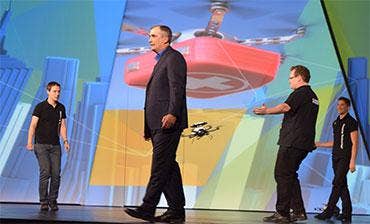Intel CEO Wows CES Crowd With Flying Bracelets, Drones, And PCs That Can 'See'
Intel CEO Brian Krzanich wowed the CES 2015 crowd Tuesday night with his vision of the future, one that features autonomous drones, a new button-size chip called Curie, and self-aware computers that can "see." Krzanich not only promised Intel chips would shape the future, but also vowed that Intel would lead by example and outlined a $300 million dollar investment to bring diversity to its workforce.
"The rise of new personal computing experiences, intelligent and connected devices, and the wearable revolution are redefining the relationship between consumers and technology," Krzanich said. "Our goal with Intel technology is to help solve real problems and enable experiences that are truly desired by people and businesses."
Krzanich said Intel was determined to fuel three major forces driving a digital revolution that is changing the way consumers and businesses use technology, including "computing unleashed, intelligence everywhere, and a wearable revolution."
/**/ /**/
/**/ brightcove.createExperiences(); /**/ [Related Video: Intel Unleashes Smart Drones At CES 2015]
"2015 is truly a unique year. It's the beginning of the next consumer technology wave," he said.
On stage Krzanich was joined by a parade of powerhouse partners that demonstrated how Intel was making good on its present, near-, and long-term road maps for Intel's technology.
Hewlett-Packard's Dion Weisler, who is currently executive vice president of HP Printing and Personal Systems but is poised to become the CEO of HP Inc. after the company splits, showed how Intel was powering HP's Multi Jet Fusion 3D printing technology. Weisler also demonstrated HP's blended reality computer Sprout.
iRobot CEO Colin Angle also joined Krzanich on stage in a virtual form via a rolling robot and big flat-panel display. Lastly, Oakley CEO Colin Baden joined Intel's CEO to talk about how the company will be working with Intel to build upcoming vision products.
Along with laying out its long-term road map, Krzanich stressed Intel's current goals with its RealSense technology that uses a voice- and gesture-control system. The RealSense technology, Krzanich said, would be inside a swath of consumer and business laptops and tablets. On stage he showed Dell's newest Venue 8 7000 tablet that uses the RealSense technology.
"You'll no longer be chained to your computer by wires," he said during a demonstration of the RealSense gesture control by navigating a recipe on a Lenovo laptop during a mock cooking demo.
Intel also announced a partnership with Marriott, Hilton, San Francisco International Airport, and others to offer wireless charging at select locations. Though he didn't mention it by name, Krzanich was referring to its upcoming Skylake chip, which is expected to enable wireless charging and data streaming between PCs. The chip is expected to be available to developers in the first half of 2015.
NEXT: Autonomous Drones Take Over Intel Keynote

The real showstopper in Krzanich's keynote was a fleet of drones used live on stage to demonstrate Intel's RealSense technology. Drones equipped with the technology were programmed to navigate around and avoid obstacles and people as they went from point A to B.
Intel also showed off the work of a small Intel developer called Nixie that makes a wearable, autonomous drone that can take selfies. On stage Krzanich demonstrated the technology as a Nixie representative took a wearable drone bracelet off and set it on a table. Next, the tiny drone flew up and hovered above them, snapped a picture, and landed back down on a table.
The chip giant, whose chips power more than 95 percent of the world's PCs, is pushing hard into new markets such as mobile devices, wearables, and the Internet of Things. To that end, Krzanich unveiled a button-size computer chip called Curie that he said would be available later in 2015.
"With this product [partners] can deliver wearables in a range of form factors," Krzanich said. "Rings, bags, bracelets, pendants, and yes, even the buttons on our jackets."
As Intel demonstrated, Curie has already been incorporated into a sight-assisting jacket that uses the RealSense technology and sensors to help sight-impaired people navigate their personal space with sensors that vibrate when people and objects come within their vicinity.
Krzanich book-ended his keynote with a $300 million pledge to improve diversity within the Intel workforce. The initiative includes a five-year investment in math-related education and similar programs to help train and employ more women and minorities in the technology and the video game industries.
By its own acknowledgment, Intel can do better at hiring minorities. According to Intel, one-quarter of its U.S. employees in 2013 were women and 12 percent of its workforce were Hispanic or African American. "Intel can do better and so can the rest of the industry," Krzanich said.
He said by 2020 Intel's own U.S. workforce would match the demographic mix of the country.
PUBLISHED JAN. 6, 2015